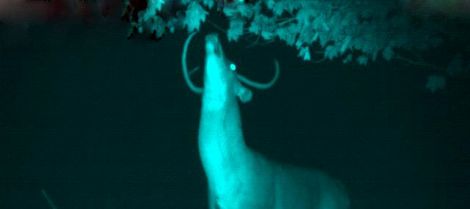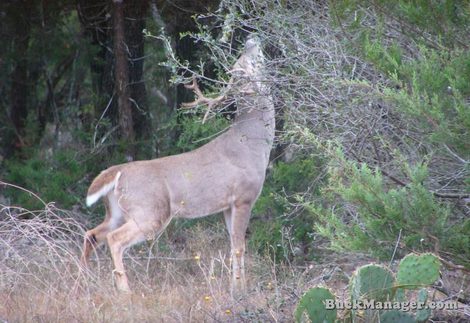Looking to harvest a good white-tailed buck? Who isn’t? I’m going to first assume that you have a place to hunt and know the terrain of your hunting property. If not, this is critical information you need to know, so get out there. In addition to learning the lay of the land, another one of a hunter’s first objectives should be to determine whether or not the hunting area holds any sizable bucks. And I use the term “sizable” as defined by you. To some, sizable may go hand-in-hand with the term “mature buck” while others may put a number to it, such as 140 Boone and Crockett points.
Big bucks are territorial. You can find these areas by looking for both scrapes and rubs, but scrapes are really what you want to be looking for and I will explain why. Other than how they are made, do you know how scrapes and rubs differ? For one, it’s seldom that one particular buck rub will be worked again later in the year. In fact, a certain tree may be rubbed in consecutive years by a particular buck, but seldom is it ever worked again during that same year. This is not the case with buck scrapes because they will often be revisited and reworked throughout the breeding season. Keep in mind that I am not saying that all whitetail scrapes will be revisited, but the odds are more in your favor than against you.

Scrape hunting can work on all age classes of bucks, but is more effective on older, and typically larger, white-tailed deer. This is because when mature bucks create a scrape they are basically laying claim to one particular area. When a big buck works the ground he is leaving a visual sign that he considers the area to be his and his only. The buck leaves visual sign on the ground with his hooves and scent from his pre-orbital glands on a licking branch above the scrape. All this is done to “claim” the area and let receptive does know that he is in around.
To sum up, while scouting your hunting area look for both rubs and scrapes. Rubs on large diameter trees will let you know that a big buck has been in the area, but a scrape is more likely to tell you where he will return. Once an active scrape is found, monitor the buck scrape, do a scrape switch, or set up downwind and wait him out. Hunting a scrape probably will not work on any given day, but be patient and over time it will give you a good shot at a buck you may not have seen otherwise.

The other day I was out deer hunting and I came upon a field. I followed that field’s perimeter until a point where the entire length of one side of the field is bordered by really wide creek. It’s about 200 yards through the woods until you get to the creek, so I just randomly picked a good trail that I seen had been worked pretty good. I had planned to ease in and find a nice tree to sit at, but while I was doing that I jumped two deer. I don’t know why but I decided to sit down. About 15 minutes later, I see a glimmer in through this thick brush that I was looking through and noticed that it was a buck making a rub.
I watched him for about 5 minutes and then I noticed another one so I decided to make a couple of grunts on my call, but it seemed that they just were not interested at all. I watched them walk on down the creek, but then because I really couldn’t see them I assumed they were gone. I waited until about 5:40 and then about 15 turkeys came through and headed back the way I saw the two bucks go. Then, about 5 minutes after that I noted the two whitetail bucks had crossed on to my right side and they were heading right for me.
At that time I noticed that these two bucks were massive. The one in front was younger and his antlers had just a little more mass, but one side of his antlers were just ugly. The one behind was perfect. The width was unbelievable and his rack was tall. So I had already made up my mind that he was the one I wanted. I watched happily as the made their way in range but the younger was coming in too fast and I was on the ground, so I was worried then.
He stopped 25 yards away and was looking dead at me and I thought about taking him but I didn’t and waited for the other to cath up. The bigger buck came to exactly 35 yards, and that would have been fine if he would have just gave me a clear shot because he was in the thick stuff. He kept looking my way and I was waiting for him to look down or away so I could pull my crossbow up and get a shot, but he stared at me for like 5 minutes straight. I was sure he was on to me so the moment he turned his head I pulled up, but I did it in a hurry because I just knew he was going to run, so I flinched big time.
I then watched the arrow sail just to his left and stick in a small tree. So I had to watch in disgust as the big white-tailed buck high-tailed it out of there. Having said that, I was wondering if there is a chance the he will return to that scrape that I had watched him make. I am seriously having nightmares about that day and I know if I get another chance, I won’t miss.
Nathan, I am a bit confused because you first mentioned that the bucks were making rubs, then at the end you mention scrapes. However, since whitetail bucks make rubs more actively earlier in the season I can only assume you are talking about rubs.
The deer will return. It sounds like you have found a good travel corridor for wildife since both deer and turkeys were encountered in the area. Because bucks create scrapes to let the ladies know they are in the area, bucks will usually return to their scrapes to see if any does have visited the scrapes. So the bucks will be back, but if you have the time I would let things settle down for at least a week before you move sneak back in.
About three days ago I was in an area I have not hunted yet this year due to too many hunters in the few areas I regularly hunt. I went into the new area and kind of did a still/scouting hunt. I came across an older scrape that had about two or three fresh marks in it. I’m assuming hoof marks. About ten yards away was a very small tree sprout about a half inch in diameter that had an older rub on it.
Because of the fresh re-marked scrape I sat on it for a couple of hours grunting, does bleating, and rattling. I went back in today (three days later) and went to the same spot. I found that a buck had come in and rubbed about another 5-7 small trees about three inches in diameter but has not touched the scrape or made any new scrapes. I have not seen the buck(s) yet, but wondering if one will be back in the area with all of the rubs?
At the site with the rubs, I also encountered what I think was a rub on a branch sticking off of a tree at my ahead level about six feet off of the ground. It was about the same height that a moose should make a rub. Is this from the same buck? Will a buck get up a little bit on his hind legs to rub branches?
Keith, many bucks will use an active scrape. It sounds like the scrape you found may have some activity, so I expect some animals will be by to check it from time to time. The rubs are relatively unimportant, as bucks will often rub their antlers in various locations. The scrape is the place to be.
As far as the rub that is located six feet up, I’m not sure what to make of it? If was that far off the ground it is highly unlikely that it belongs to a whitetail. Do you have moose, elk, exotics in your location?
What does it mean when a buck craps in a scrape or is it another buck trying to mess it up or something?
On November 30,2011 a guy named Kyle asked what does it mean when a buck craps in a scrape or is it another buck trying to mess it up or something? I would like an answer to that question since I encountered the same situation today please!!!